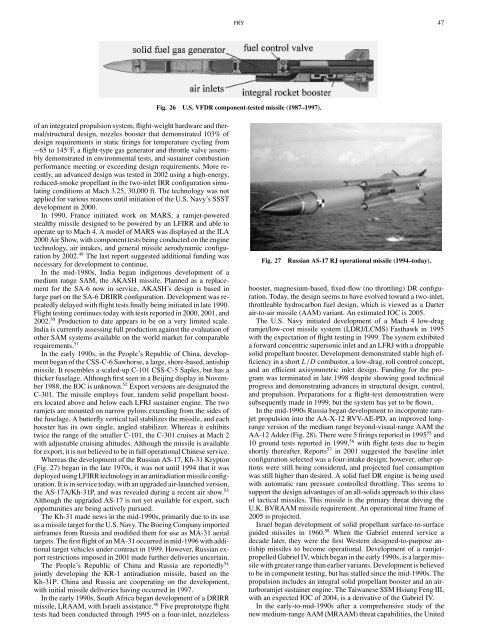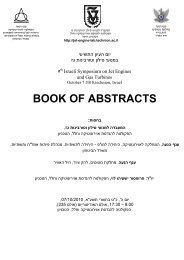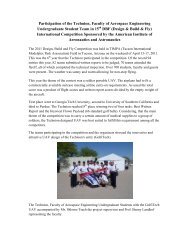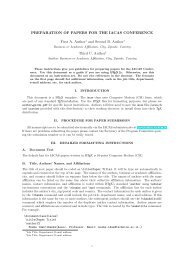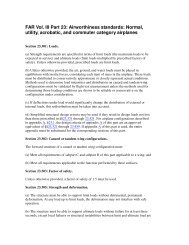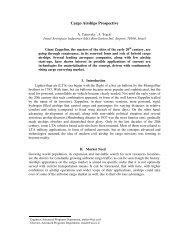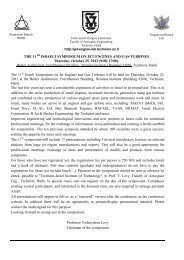A Century of Ramjet Propulsion Technology Evolution - Faculty of ...
A Century of Ramjet Propulsion Technology Evolution - Faculty of ...
A Century of Ramjet Propulsion Technology Evolution - Faculty of ...
Create successful ePaper yourself
Turn your PDF publications into a flip-book with our unique Google optimized e-Paper software.
<strong>of</strong> an integrated propulsion system, flight-weight hardware and thermal/structural<br />
design, nozzles booster that demonstrated 103% <strong>of</strong><br />
design requirements in static firings for temperature cycling from<br />
−65 to 145 ◦ F, a flight-type gas generator and throttle valve assembly<br />
demonstrated in environmental tests, and sustainer combustion<br />
performance meeting or exceeding design requirements. More recently,<br />
an advanced design was tested in 2002 using a high-energy,<br />
reduced-smoke propellant in the two-inlet IRR configuration simulating<br />
conditions at Mach 3.25, 30,000 ft. The technology was not<br />
applied for various reasons until initiation <strong>of</strong> the U.S. Navy’s SSST<br />
development in 2000.<br />
In 1990, France initiated work on MARS, a ramjet-powered<br />
stealthy missile designed to be powered by an LFIRR and able to<br />
operate up to Mach 4. A model <strong>of</strong> MARS was displayed at the ILA<br />
2000 Air Show, with component tests being conducted on the engine<br />
technology, air intakes, and general missile aerodynamic configuration<br />
by 2002. 49 The last report suggested additional funding was<br />
necessary for development to continue.<br />
In the mid-1980s, India began indigenous development <strong>of</strong> a<br />
medium range SAM, the AKASH missile. Planned as a replacement<br />
for the SA-6 now in service, AKASH’s design is based in<br />
large part on the SA-6 DRIRR configuration. Development was repeatedly<br />
delayed with flight tests finally being initiated in late 1990.<br />
Flight testing continues today with tests reported in 2000, 2001, and<br />
2002. 50 Production to date appears to be on a very limited scale.<br />
India is currently assessing full production against the evaluation <strong>of</strong><br />
other SAM systems available on the world market for comparable<br />
requirements. 51<br />
In the early 1990s, in the People’s Republic <strong>of</strong> China, development<br />
began <strong>of</strong> the CSS-C-6 Sawhorse, a large, shore-based, antiship<br />
missile. It resembles a scaled-up C-101 CSS-C-5 Saples, but has a<br />
thicker fuselage. Although first seen in a Beijing display in November<br />
1988, the IOC is unknown. 52 Export versions are designated the<br />
C-301. The missile employs four, tandem solid propellant boosters<br />
located above and below each LFRJ sustainer engine. The two<br />
ramjets are mounted on narrow pylons extending from the sides <strong>of</strong><br />
the fuselage. A butterfly vertical tail stabilizes the missile, and each<br />
booster has its own single, angled stabilizer. Whereas it exhibits<br />
twice the range <strong>of</strong> the smaller C-101, the C-301 cruises at Mach 2<br />
with adjustable cruising altitudes. Although the missile is available<br />
for export, it is not believed to be in full operational Chinese service.<br />
Whereas the development <strong>of</strong> the Russian AS-17, Kh-31 Krypton<br />
(Fig. 27) began in the late 1970s, it was not until 1994 that it was<br />
deployed using LFIRR technology in an antiradiation missile configuration.<br />
It is in service today, with an upgraded air-launched version,<br />
the AS-17A/Kh-31P, and was revealed during a recent air show. 53<br />
Although the upgraded AS-17 is not yet available for export, such<br />
opportunities are being actively pursued.<br />
The Kh-31 made news in the mid-1990s, primarily due to its use<br />
as a missile target for the U.S. Navy. The Boeing Company imported<br />
airframes from Russia and modified them for use as MA-31 aerial<br />
targets. The first flight <strong>of</strong> an MA-31 occurred in mid-1996 with additional<br />
target vehicles under contract in 1999. However, Russian export<br />
restrictions imposed in 2001 made further deliveries uncertain.<br />
The People’s Republic <strong>of</strong> China and Russia are reportedly 54<br />
jointly developing the KR-1 antiradiation missile, based on the<br />
Kh-31P. China and Russia are cooperating on the development,<br />
with initial missile deliveries having occurred in 1997.<br />
In the early 1990s, South Africa began development <strong>of</strong> a DRIRR<br />
missile, LRAAM, with Israeli assistance. 46 Five preprototype flight<br />
tests had been conducted through 1995 on a four-inlet, nozzleless<br />
FRY 47<br />
Fig. 26 U.S. VFDR component-tested missile (1987–1997).<br />
Fig. 27 Russian AS-17 RJ operational missile (1994–today).<br />
booster, magnesium-based, fixed-flow (no throttling) DR configuration.<br />
Today, the design seems to have evolved toward a two-inlet,<br />
throttleable hydrocarbon fuel design, which is viewed as a Darter<br />
air-to-air missile (AAM) variant. An estimated IOC is 2005.<br />
The U.S. Navy initiated development <strong>of</strong> a Mach 4 low-drag<br />
ramjet/low-cost missile system (LDRJ/LCMS) Fasthawk in 1995<br />
with the expectation <strong>of</strong> flight testing in 1999. The system exhibited<br />
a forward concentric supersonic inlet and an LFRJ with a droppable<br />
solid propellant booster. Development demonstrated stable high efficiency<br />
in a short L/D combustor, a low-drag, roll control concept,<br />
and an efficient axisymmetric inlet design. Funding for the program<br />
was terminated in late 1998 despite showing good technical<br />
progress and demonstrating advances in structural design, control,<br />
and propulsion. Preparations for a flight-test demonstration were<br />
subsequently made in 1999, but the system has yet to be flown.<br />
In the mid-1990s Russia began development to incorporate ramjet<br />
propulsion into the AA-X-12 RVV-AE-PD, an improved longrange<br />
version <strong>of</strong> the medium range beyond-visual-range AAM the<br />
AA-12 Adder (Fig. 28). There were 5 firings reported in 1995 55 and<br />
10 ground tests reported in 1999, 56 with flight tests due to begin<br />
shortly thereafter. Reports 57 in 2001 suggested the baseline inlet<br />
configuration selected was a four-intake design; however, other options<br />
were still being considered, and projected fuel consumption<br />
was still higher than desired. A solid fuel DR engine is being used<br />
with automatic ram pressure controlled throttling. This seems to<br />
support the design advantages <strong>of</strong> an all-solids approach to this class<br />
<strong>of</strong> tactical missiles. This missile is the primary threat driving the<br />
U.K. BVRAAM missile requirement. An operational time frame <strong>of</strong><br />
2005 is projected.<br />
Israel began development <strong>of</strong> solid propellant surface-to-surface<br />
guided missiles in 1960. 58 When the Gabriel entered service a<br />
decade later, they were the first Western designed-to-purpose antiship<br />
missiles to become operational. Development <strong>of</strong> a ramjetpropelled<br />
Gabriel IV, which began in the early 1990s, is a larger missile<br />
with greater range than earlier variants. Development is believed<br />
to be in component testing, but has stalled since the mid-1990s. The<br />
propulsion includes an integral solid propellant booster and an airturboramjet<br />
sustainer engine. The Taiwanese SSM Hsiung Feng III,<br />
with an expected IOC <strong>of</strong> 2004, is a derivative <strong>of</strong> the Gabriel IV.<br />
In the early-to-mid-1990s after a comprehensive study <strong>of</strong> the<br />
new medium-range AAM (MRAAM) threat capabilities, the United


